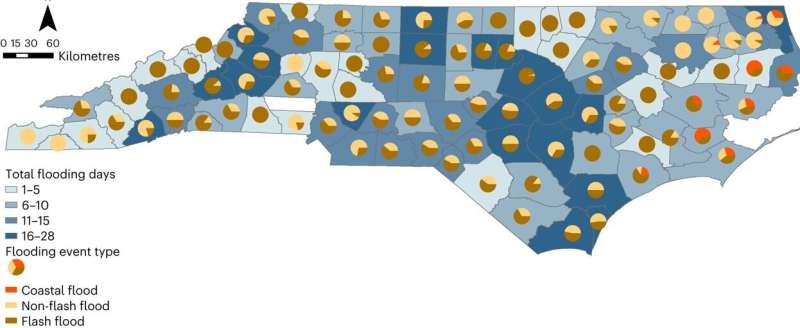This article has been reviewed according to Science X's editorial process and policies. Editors have highlighted the following attributes while ensuring the content's credibility:
fact-checked
peer-reviewed publication
trusted source
proofread
Study reveals the human health costs of exposure to floods

The cost of severe flooding in the United States is often tallied in economic terms, including a flood's impact on infrastructure.
Flooding's effect on human health is less well understood.
A new Yale School of Public Health study shows that flooding's impact on human health is much greater than is typically recognized, going beyond health issues such as the risk of accidental injury, and exposure to waterborne and infectious diseases. The Yale team found that flooding also was associated with an increased risk of mortality due to cardiovascular disease, respiratory disease, and mental disorders.
"Previously, when we've talked about costs of severe flooding we have focused on billion-dollar disaster events measured by property damage and insurance claims," said Kai Chen, assistant professor of epidemiology (environmental health) and the study's senior author. "But a majority of non-communicable diseases can also be impacted by flooding."
Titled "Association of flooding exposure with cause-specific mortality in North Carolina, United States," the study was published in the journal Nature Water. Jie Ban, visiting research scientist and the inaugural Li Foundation Climate Change Fellow, is the lead author.
The researchers reviewed data from 446,807 deaths that occurred from 2015 to 2019 across 98 counties in North Carolina, a state that has experienced a number of severe weather disasters over the past 30 years, including various types of flooding.
They compared the risk of mortality from flash floods—flooding that begins three to six hours during heavy rainfall that is often caused by thunderstorms—and longer-duration floods that take place over one day or multiple days. They were surprised that the two types of flooding—acute and fast flash floods, and days-long floods—showed similar outcomes.
"There are some differences," Chen said. "The non-flash floods have higher total attributable deaths than flash floods, but overall, they are comparable in terms of risks."
They also reviewed the risk of accidental and non-accidental death among both young and older people, again, with surprising results.
"Another interesting finding was that we saw a difference between not only the types of floods, but the people who died because of exposure to flooding," Chen said. "We see that older adults have an increased risk for accidental death, but young people actually have a higher risk for non-accidental death due to flooding."
Accidental deaths include those caused by falling and drowning. Non-accidental deaths include deaths from cardiovascular disease, respiratory diseases, and mental disorders. The researchers controlled for factors at the county level such as poverty and access to health care. They also controlled for temperature and precipitation rates in their model.
"Our study finds potential associations between flooding exposure and the increased non-accidental mortality risk for both younger and older groups, with higher risk observed in the younger groups aged 0–64 years old," Chen said.
The study suggests that exposure to flooding can cause respiratory and related allergic health effects due to dampness or mold. Also, the impact of flooding disasters on mental stress appears to be more pronounced in younger people. Older people may experience lower non-accidental mortality risk because of their preparedness with routine medications and health care, Chen explained.
"We might expect that overall, older adults with lower mobility and higher rates of chronic illness would have higher non-accidental mortality compared to younger, healthier people. But the younger people have higher non-accidental deaths. I think that's surprising," Chen said.
"We saw that older adults, when it comes to drowning or injury causing accidental death, have a larger risk," he added.
Chen and his team plan to extend their research on flooding exposure and mortality to states in the eastern and western U.S. This way they can provide a broader understanding of how flooding impacts human health, and potentially support the design of effective health interventions that can be used during disaster emergencies.
Chen's research group also recently published a study showing the link between severe flooding and increased diarrhea risk in children. In an analysis of cross-sectional data from 43 low- and middle-income countries, researchers found that severe flooding—flooding that lasted more than two weeks—and flooding following periods of drought were associated with an increased risk of diarrhea among younger children.
More information: Jie Ban et al, Association of flooding exposure with cause-specific mortality in North Carolina, United States, Nature Water (2023). DOI: 10.1038/s44221-023-00167-5




















